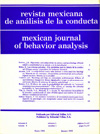Matching and bias on cocurrent performances: Effects of asymmetrical changeover delays
Main Article Content
Abstract
Five pigeons were exposed to concurrent variable-interval, variable-interval schedules, one of five different pairs of schedules assigned to each subject. On the first experimental condition, symmetrical 3-sec changeover delays (Con> were iii effect. On the second condition, the 3-sec COD was in effect only for changeovers from the white to the green key color. On the third condition, the COD contingency was reversed: there was no COD for changeovers from white to green, and a 3-sec COn was in effect for changeovers in the opposite direction. For every session, group data from the five pigeons was used to compute the parameters of the generalized matching law R,/R2 = k(ri/r2)a. The asymmetry in changeover delays affected bias (it) and matching (a). When the 3-sec COD was associated with the green color, response distribution produced bias toward the green color, and time distribution indicated bias toward the white color. Such results were confinned when the asymmetrical COD contingency was reversed: response bias toward the schedule associated with the COD, time bias toward the other schedule of the associated pair. Exponents (a) for time and response distributions were approximately equal for symmetrical CO1)s, and systematically different for asymmetrical CODs: the exponent for response distribution was higher thai, for time distribution. Result indicated that the effects of asymmetrical CODs on bias and matching are similar to those observed on concurrent fixed-ratio, variable-intcrval schedules. In both cases, changes in bias and matching may be due to changes in local response rates.
